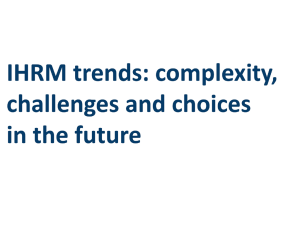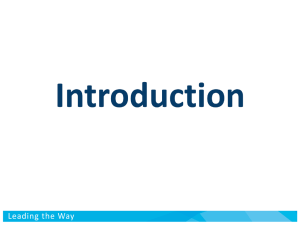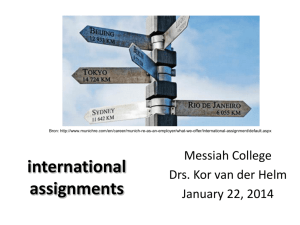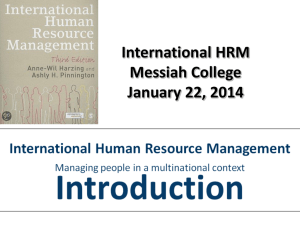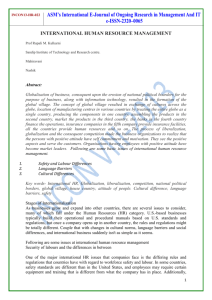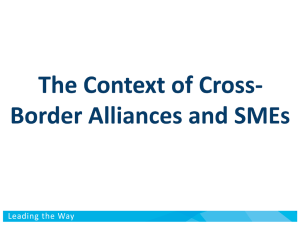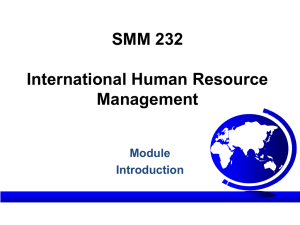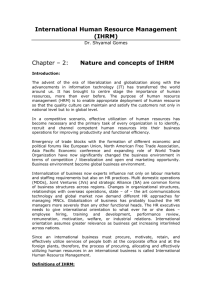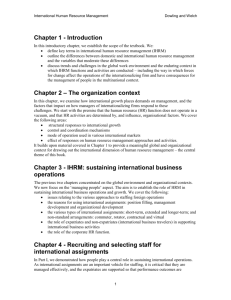Chapter 04
advertisement
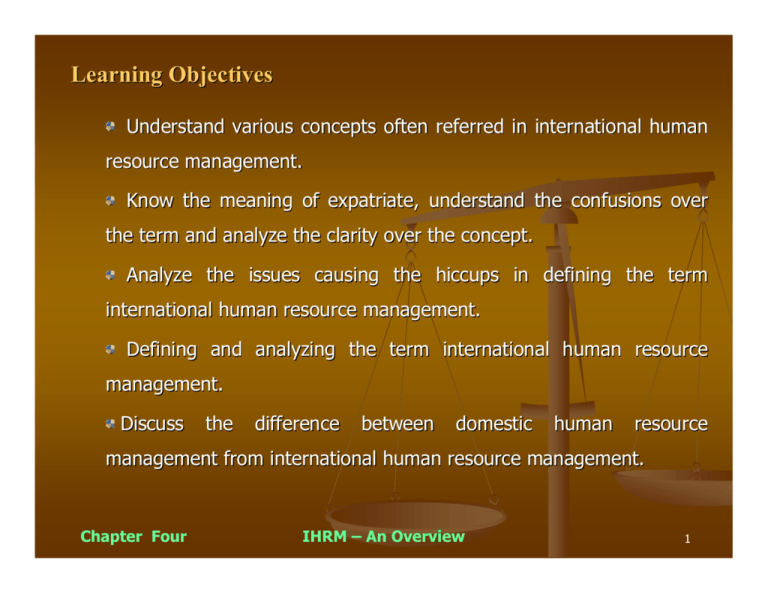
Learning Objectives Understand various concepts often referred in international human resource management. Know the meaning of expatriate, understand the confusions over the term and analyze the clarity over the concept. Analyze the issues causing the hiccups in defining the term international human resource management. Defining and analyzing the term international human resource management. Discuss the difference between domestic human resource management from international human resource management. Chapter Four IHRM – An Overview 1 Structure 1) Introduction 2) Concept of ‘Expatriate’ : Confusion in Usage. 3) What is International Human Resource Management?. 4) Domestic vs. International HRM. 5) Conclusion 6) Summary. Chapter Four IHRM – An Overview 2 4.1 Introduction Before we embark on study of IHRM, let us know what it is, how does it differ from HRM , is it a synonym for cross-cultural management & what are often used specific terms like MNCs, TNCs etc. MNC – is an organization which operates in more than one country. Transnational Corporation [TNC]- is an organization that produces, markets, invests, and operates across the world. Home Country / Parent country – is the one where the head quarters of the MNC or TNC is located. Host country – is the country where the branch or subsidiary of an MNC/TNC is located. Chapter Four IHRM – An Overview 3 4.1 Introduction Parent [Home] Country Nationals [PCN]– are employees of an MNC/TNC who are the citizens of home country / parent country of the MNC / TNC. Host Country Nationals [HCN] – are employees of an MNC/TNC subsidiary, branch who are the citizens of the country where the subsidiary or the branch of the MNC / TNC is located. Third Country Nationals [TCN] – are employees of an MNC/TNC or their subsidiaries , branches and are the citizens of those countries which are not home country / parent country or host country of the MNC / TNC Chapter Four IHRM – An Overview 4 4.1 Introduction Advantages and disadvantages of employing citizens from parent, host and third countries: PCN Advantages: Familiarity with the goals, objectives, policies, systems, procedures and practices of the headquarters. Effective liaison and communication with home office personnel. Easier exercise of control over the subsidiaries operations. PCN Disadvantages: Difficulties in adapting to the foreign language, culture and environmental issues like socio economic, political & legal conditions. Chapter Four IHRM – An Overview 5 4.1 Introduction PCN Disadvantages: Excessive cost of maintaining expatriate managers and their families abroad. The loss of jobs for host country. Family adjustment problems and its adverse effects on productivity of PCN. HCN Advantages: Familiarity with the culture and environment factors like socio economic, political & legal conditions and with business practices of the host country. Lower cost of staff. Chapter Four IHRM – An Overview 6 4.1 Introduction HCN Advantages: Provides opportunities for human resource development of HCNs leading to increase in their commitment and motivation. HCN Disadvantages: Difficulties in exercising effective control over the subsidiary’s operations Communication difficulties in dealing with the headquarters. Lack of opportunities for gaining international or cross cultural experience. Chapter Four IHRM – An Overview 7 4.1 Introduction TCN Advantages: Compromise between PCNs and HCNs TCNs are usually career international business managers. TCN are less expensive than PCN. TCNs may be better informed about the host environment than the PCN. TCN Disadvantages: Host country’s sensitivity with respect to nationals of specific countries. Local nationals are impeded in their efforts to upgrade their own ranks and assume responsible positions in multi national subsidiaries. Chapter Four IHRM – An Overview 8 4.2 Concept of ‘Expatriate’ : Confusion in Usage. Dictionary meaning of expatriate is “ one who left the home land.” The term expatriate from the point view of IHRM is the one who is working and residing in a foreign country to serve the tenure of foreign employment. Expatriate include i] foreign employees working in domestic companies, ii] parent country nationals working in MNC’s subsidiary, iii] third country nationals working in MNCs and iv] host country nationals working in the parent country of the MNC / TNC. In short expatriate is an employee working and living in a foreign country where he/she is non-citizen. Some MNCs use the term inpatriate to denote those employees transferred from subsidiaries to headquarters. But this term is not to be conceptualized for study of IHRM. Chapter Four IHRM – An Overview 9 Foreigner Working in a Domestic firm Subsidiary national Working in HQ Expatriates Third country national Working in a Subsidiary or HQ Parent country national working In a subsidiary Chapter Four IHRM – An Overview 10 4.2 Concept of ‘Expatriate’ : Confusion in Usage. Work Permit: almost all the countries impose a restriction for foreigners on right to work or seek employment in their countries. The foreigners / non-citizens are normally required to obtain work permit . It is a document issued by the Government of the country concerned [mostly by the Department of Immigration] granting right to foreigners to seek employment in the country concerned. Guest Employees: Foreigners with distinctive and rare skills are invited to perform certain activities during a specified period. Such foreign employees are called ‘Guest Employees’. Chapter Four IHRM – An Overview 11 4.3 What is HRM? Human Resource management is managing procurement, development, compensation, integration and maintenance of people of an organization in order to contribute duly to the individual , organizational and social goals. The significant HRM activities include :; ; ; ; Job work design and job analysis. Human resource planning. Recruitment. Selection, placement and induction. Chapter Four IHRM – An Overview 12 4.3 What is HRM? ; Performance management. ; Training. & development ; Career planning & development. ; Remuneration and benefits. ; Human relations [ motivation, leadership, morale, team work, empowerment, grievance redress, cross-cultural management , social relations]. ; Industrial relations [union-management negotiations, participative management, disputes prevention and settlement.] Chapter Four IHRM – An Overview 13 4.3 What is IHRM? IHRM is not a new concept and in fact it is not the emergence of recent phase of globalization. It is as old as the first phase of the globalization. It is not the same as cross culture management. It is, however, true that the significance, popularity and complexity of IHRM have been due to the current phase of globalization. The strides of information technology have brought significant changes in the scope and dimensions of IHRM. A fully domestic company but employing a few foreign nationals, MNC employing only host country national in its branches or MNC employing only parent country national at HQ seems to be outside the purview of IHRM. But that is not true! Chapter Four IHRM – An Overview 14 4.3 What is IHRM? IHRM is also defined as an interplay among human activities [procure, allocate and utilize] ; countries [home, host and others] and types of employees [PCNs, HCNs and TCNs]. This definition does not IHRM activities of immigration and foreign national working in a domestic company. Hence better definition is “performing HRM and its related activities and arranging for related and necessary cultural and immigration facilities for prospective and current employees, by organizations operating in domestic or foreign countries. Now we can seek differences between HRM and IHRM. Chapter Four IHRM – An Overview 15 4.4 Domestic Versus International HRM? Types of Organizations Domestic firms employing foreigners. Parent companies. Joint ventures. Subsidiary company. Others operating in foreign countries. Types of Human Resources International HR Activities • Domestic HR / nationals of the host country. • Parent company nationals. • Third country nationals. • Other types of foreign employees. Chapter Four IHRM – An Overview • Procuring. Developing. • Compensating. Utilizing. • Immigration/ Migration • Socialization, Security. • Repatriation. Deportation • Cross cultural management 16 4.4 Domestic Versus International HRM? Wider Nationalities Broader Relationships & complexities Different approaches of functions International HRM Variety of functions Influence of international environment Enduring Complexities of HRM activities Chapter Four IHRM – An Overview 17 4.4 Domestic Versus International HRM? 1. Wider Nationalities Culture that influences IHRM of a few countries is described here Japan: Japanese culture is based on peace and harmony. It ranks high pragmatism, masculinity, uncertainty avoidance and power distance. Japanese attach importance to loyalty, empathy and guidance to subordinates. They emphasize on participative management, consensus problem solving and decision making and work like in a family system. They avoid open expression and conflicts. Show devotion to work, collective responsibility and high employee productivity. Chapter Four IHRM – An Overview 18 4.4 Domestic Versus International HRM? America: Americans are mostly individualistic. Their behavioural aspects include, risk taking, bold initiative, acting spontaneously, outspoken, critical thinking, logical reasoning, clarity and frankness, confronting and threatening. In view of these, wide variations in their cultures, there are major conflicting situations when Japanese work for the American firms and Americans in firms in Japan. Americans offend the indirectness and sensitivity of Japanese who show patience. Japanese think that Americans have no spiritual quality and little employee loyalty. Chapter Four IHRM – An Overview 19 4.4 Domestic Versus International HRM? Germany: Though the Germans rank high on individualism, the behaviour of Germans is less individualistic than that of Americans. They are high on uncertainty avoidance , masculinity, and less on power distance. Germans prefer to move around familiar people and situations. They delve on detailed evaluation before committing themselves. They are more rule minded and strict with the use of time. Decision making is not highly centralized and in fact is by consensus. They follow strict departmentalization, division of work, closed door policy. German is a low context society and communication is explicit. Chapter Four IHRM – An Overview 20 4.4 Domestic Versus International HRM? South Korea: Koreans are high on collectivism and pragmatism, low on masculinity, moderate on power distance and high on uncertainty avoidance. They follow traditional Confucian teachings of spiritualism and collectivism. They respect family, authority, formality, class and rank in the society. They are aggressive hard working, demonstrative, friendly and hospitable. They emphasize on family relationships, personal relationships network etc. Business is based on honour and trust and most of the contracts are oral. They like praise but not criticism. Chapter Four IHRM – An Overview 21 4.4 Domestic Versus International HRM? Saudi Arabia: Islam permeates Saudi life. Allah is always present , controls everything, and is frequently referred to in conversation. Employees spend more than two hours a day in prayer. Work culture / behaviour is mixed with religion, politics and social life. contracts are oral. They like praise but not criticism. Arab culture has norms of reciprocity of favours, support and obligation. Family relation and personal relations are close. Outsiders have to establish trusting relationship and honour before establishing any business relationships. Use of swear words , commenting on a man’s family or grown up children, use of alcohol are all banned. Sexes are to be separated. Chapter Four IHRM – An Overview 22 4.4 Domestic Versus International HRM? China: Small business is peculiar to China and the extended families run the small businesses. Members of the extended family are also partners in different stages of supply and value chain. Guanxi is prevalent in China that indicates the network of relationships that the Chinese cultivate through friendship, exchange of favours and gifts to provide an obligation to reciprocate favours. Major difference between Chinese management style and the Western management style is the human centeredness that put people ahead of business relationship, but based on friendship, loyalty and trust. Chapter Four IHRM – An Overview 23 4.4 Domestic Versus International HRM? India: Indians are high on collectivism in case of family relations and individualistic at work place. Family relations and social relations are strong. They are also high on power distance and masculinity. They respect family authority, social class and rank. They are aggressive , hard working, demonstrative, friendly and hospitable. They meet challenges and thrive on for goals. Business is based on trust and honesty and most of the contracts are oral. Indians are loyal to the organization. HR managers are well aware of the culture of their home country. When they have to deal with nationals of other countries in their home country or abroad, they should understand the culture of the countries to which their colleagues belong. Chapter Four IHRM – An Overview 24 4.4 Domestic Versus International HRM? 2. Broader Relations and Complexities When dealing with cross cultural employees under IHRM, HR manager needs data on broader aspects of the employees and their families. This additional data allows the HR manager to arrange visa, work permits, suitable accommodation and socialization of foreign employees & their families. He has to assist them for their shopping, hotels, education, entertainment and visits to religious places [ church for Catholics]. Thus international HRM does result in more complexity in understanding people, managing them, meeting their wider needs and providing all kinds of security , in addition to building and developing wider relations. Chapter Four IHRM – An Overview 25 4.4 Domestic Versus International HRM? 3. Influence of International Environment International environment has become complex, highly competitive, dynamic, vibrant, intertwined and interdependent. With globalization difference between domestic and international is narrowing. Regional integration has resulted in free flow of human resource from poor to rich countries and brought down average wages & increased unemployment in developed countries. Stride in business processes like e-business has changed the business processes and patterns from procuring raw materials to the stage of selling, and outsourcing, call centers , post sales service etc. This increased the demand for international human resources but reduced their physical flow. This enhanced the role of IHRM which now has to blend HRM of both the countries. Chapter Four IHRM – An Overview 26 4.4 Domestic Versus International HRM? 3. Influence of International Environment Further information technology allows location of manufacturing centres in various countries with help of computer aided manufacturing techniques , thus creating opportunities for employment in various countries. Large scale out sourcing resorted to by MNCs also increased employment in domestic companies in countries like India, China Vietnam and Malaysia. Many cases HR functions for this workforce is carried by HR personnel of the respective MNC headquarters. This brings IHRM into play. Political liberalization has narrowed gulf between capitalism and communism removing entry barriers for MNCs behind so called iron curtain. IHRM scope is thus enhancing is changing based on political & economic environment of home, host and other countries. Chapter Four IHRM – An Overview 27 4.4 Domestic Versus International HRM? 4. Enduring Complexities of IHRM Activities With globalizations we observed MNCs are employing nationals as well as expatriates. This has resulted into IHRM becoming complex as it has to practice different HR policies for nationals and expatriates. Increased salary levels, dependent on country of origin, are necessary for expatriates who have to get assimilated into a foreign culture. The motivational techniques, leader follower interactive techniques would also differ for nationals and expatriates. These different treatments have to be managed tactfully under IHRM, without causing any frustration to nationals in the organization. This a continuous and complex task. Chapter Four IHRM – An Overview 28 4.4 Domestic Versus International HRM? 4. Enduring Complexities of IHRM Activities Even among expatriates, it is always not prudent to have a uniform compensation package. These significant variations in salaries, benefits, motivation, retaining strategies, treatment, interpersonal relations and approach towards employees vary based on the country of origin and create complexities in IHRM. In addition, salary increases provided on the basis of job performance are also viewed by employees through such discriminatory lenses. IHR managers are required to conduct counseling sessions to make employees realize philosophy, reasoning and need for payment of such differential salaries and benefits. Chapter Four IHRM – An Overview 29 4.4 Domestic Versus International HRM? 5. Variety of Functions. Additional functions under IHRM : Information about cultures, employee families. Exhaustive data regarding culture, currency, repatriation of funds procedures, medical or educational facilities, economy, income tax structure, has to be provided to prospective candidates. Checking the record of terrorist / Criminal Activities. On-line selection techniques and process. Chapter Four IHRM – An Overview 30 4.4 Domestic Versus International HRM? 5. Variety of Functions. Additional functions under IHRM : - contd. Immigration Information. Immigration compliance. Air Ticketing Receiving candidates on arrival. Conducting language classes and arranging translators. Designing Salary Packages to suit country specific tax structure. Special training. Liaison with Immigration Officials. Chapter Four IHRM – An Overview 31 4.4 Domestic Versus International HRM? 6. Different Approaches to Domestic HRM Functions: HR functions like Recruitment, Selection, Induction and Placement, or Training & development or Salary Administration & benefits or Retention management & Maintenance all require different approaches as employees are from different countries and hence approach for each activity has to be tailor made for the country of origin of the employee. Remuneration function and policy has to be different for national and expatriates as their needs are totally different. Even among expatriates the remuneration has to be designed for the country of origin. Chapter Four IHRM – An Overview 32 4.5 Conclusion Variety of complexities, operations and functions are involved under IHRM and hence it is difficult to define IHRM. IHRM differs from domestic HRM in six major dimensions like :wider nationalities of employees variety of functions to be performed. influence of international environment. broader and deeper relationships. different approaches to the domestic functions and enduring complexity of international HRM. Chapter Four IHRM – An Overview 33 4.6 Summary Ô Ô Ô Ô Ô MNC is an organization which operates in more than one country. Transnational corporation TNC is an organization that produces, markets, invests and operates across the world. Home Country / Parent Country is the one where the headquarters of the MNC or TNC is located. Host Country is the one where the subsidiary / branch of an MNC / TNC is located. Home country nationals are employees of an MNC/TNC who are the citizens of home / parent country of that MNC/TNC , but working in a subsidiary / branch in host country. Chapter Four IHRM – An Overview 34 4.6 Summary Ô Ô Ô Ô Host country nationals are employees of an MNC/TNC subsidiary / branch who are the citizens of the country where the subsidiary / branch of MNC /TNC is located. Third country nationals are employees of an MNC/TNC or their subsidiary / branch and are citizens of those countries other than the MNC /TNC’s home or host country. Expatriate is an employee working and living in a foreign country where he/she is a non-citizen. Work permit is a document issued by the Government of the country concerned [mostly by the department of immigration] granting right to foreigners to seek employment in the country concerned. Chapter Four IHRM – An Overview 35 4.6 Summary Ô Ô Ô Persons with distinctive and rare skills are invited to perform certain activities during a specified period . Such foreign employees are called ‘guest employees.’ IHRM is defined as , performing HRM and its related activities and arranging for related and necessary immigration facilities for prospective and current expatriate employees, by organizations operating in domestic and/or foreign countries. Domestic is different from International HRM due to various aspects like i] wider nationalities of employees, ii] variety of functions to be performed, iii] influence of international environment, iv] broader and deeper relationships, v] different approaches for the domestic functions and vi] enduring complexity of international HRM. Chapter Four IHRM – An Overview 36 This brings us to the end of this fourth session on “International Human Resource Management – An Overview” Next we move to the fifth session on chapter five “International Human Resource Planning Good Luck! Chapter Four IHRM – An Overview 37
